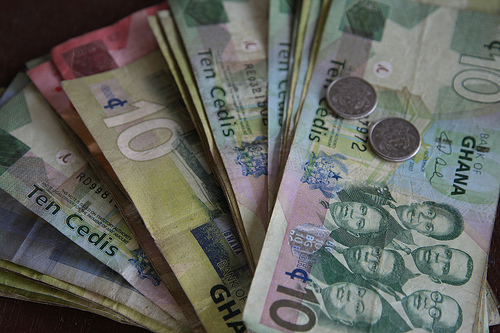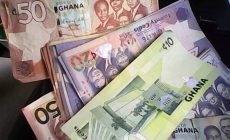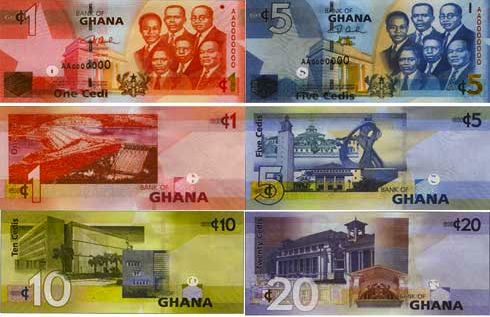Ghana Cedi loses 44% value in 17 months
- Posted on
- Comment
 The local currency continues to attain record lows on the back of its poor performance which began at the beginning of January 2014 – losing cumulatively about half of its value since then.
The local currency continues to attain record lows on the back of its poor performance which began at the beginning of January 2014 – losing cumulatively about half of its value since then.
The fall in the value of the cedi has put significant pressure on the pockets of consumers as import inflation gathers momentum amidst increasing cost of living and doing business fueled by the unending erratic power supply.
Analysis by the B&FT shows that since January 2014, the cedi has lost 43.8 percent of its value to the US dollar despite a raft of measures introduced by the central bank and an International Monetary Fund programme to stem the rapid depreciation.
Last year the cedi lost about 31 percent of its value after a string of poor performances largely in the first half of the year. The slide prompted the central bank to introduce forex restrictions which market players accused of being counterproductive.
The measures were later withdrawn and it took the combined proceeds of US$3 billion from the Eurobond and the cocoa syndicated loan to breathe a new lease of life into the cedi in the second half of 2014.
But despite announcing the Fund’s programme and subsequent arrival of the first tranche of US$114.8 million, the cedi’s remarkably poor performance has seen it lose 18.6 percent to the greenback this year alone.
The central bank seems helpless in containing the slide of the cedi with policies either hit and miss or largely misguided as the fall in the value of cedi is nearing the frightening level it reached last year which prompted the introduction of some unconventional measures such as the forex restrictions described by many as a failure but trumpeted by officials of the Bank of Ghana as a success.
Comparatively, within the same period last year – that is between January and May 26 – the cedi performed poorly when it lost 23.3 percent of its value.
The cedi’s abysmal performance since January 2014 has largely stoked inflationary pressures. Within that same period, inflation has risen from 13.8 percent to 16.8 percent as at last month.
Governor of the Central Bank Dr. Kofi Wampah at the MPC meeting earlier this month said developments in the foreign exchange market indicate a further weakening of the domestic currency in 2015.
While government had insisted the first tranche should offer some much-needed balance of payments support, economists at InvestCorp argue that the inflows from the IMF, which average US$306million per year, are “limited compared to the financing gap of about US$2billion in the 2015 budget and an expected current account deficit of about US$3- 4billion in 2016”.
Just like InvestCorp, most analysts view the cedi’s weakness as a product of macroeconomic- instability underlined by high fiscal and current account deficits, which necessitated the country seeking a bailout from the Bretton Woods organisation.
The Accra-based investment advisory firm warned that the local currency is further threatened by government’s debt financing strategy – which has seen the increasing use of US dollar denominated debt as a refinancing strategy.
But in its April report, InvestCorp said: “While concern about currency risk is. real for Ghana, there is clear evidence of the yield on the benchmark 91-day Treasury bill having a sustained edge over the corresponding depreciation of the cedi across a 3-year cycle. Essentially, investors in
Ghana’s domestic debt market could be compensated for currency risk with well-structured debt instruments over the medium-term”.
Slowing momentum
Ghana’s economic growth rate topped 9 percent in 2011, but 1 three difficult years followed that were characterised by slowing I activity, accelerating inflation, J and rising debt levels and r financial vulnerabilities.
The country’s economic prospects were put at risk by the emergence of large fiscal and — external imbalances, as well as by electricity shortages.
Growth decelerated markedly in 2014, to an estimated 4.2 percent, driven by a sharp contraction in the industrial and service sectors. This was largely L due to the negative impact of the currency depreciation on input costs, declining domestic demand, and increasing power outages.
Inflationary pressures rose on the back of the cedi’s large depreciation and financing the fiscal deficit by the Bank of Ghana. Despite several hikes in policy interest rates in2014, which brought them to 21 percent, headline inflation reached 17 percent at end-2014 – well above the 8 +/- 2 percent official target range.
– BFT










 (Selorm) |
(Selorm) |  (Nana Kwesi)
(Nana Kwesi)